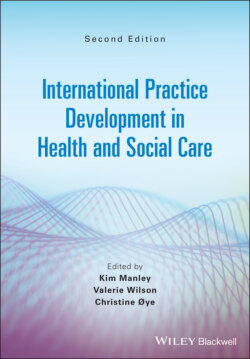Читать книгу International Practice Development in Health and Social Care - Группа авторов - Страница 39
Building contextual readiness – Cathy’s nemesis and enlightenment
ОглавлениеIt is understood that the principles, tools and methodological processes of PD can be implemented successfully in varied and diverse environments. However, it is essential that all approaches are contextually sensitive to place and person. What is described as an enabler in one setting may be seen very differently in another; what is acceptable, desirable and a priority in one setting may be met with indifference in another.
The context and the characteristics of teams in terms of assumptions, values and beliefs are organic, developed and sustained by the people within the organisation. One observed consequence of these characteristics is clinical variation in outcomes in maternity care where the variations cannot be explained by the characteristics or demographics of the women alone (Lee et al. 2013; Women’s Healthcare Australasia 2014). The relationships between care providers, collaborative approaches to care and aspects of team dynamics can influence clinical outcomes (Hastie and Fahy 2011; Downe et al. 2009; Raab et al. 2013). Understanding the significance of context in a change process is crucial to maximise effectiveness. Lack of recognition or understanding of the influence of context has been described as the root cause of mediocre success of programmes regardless of the integrity of, or evidence for, the change (Glasgow et al. 2013; Krein et al. 2010; Taylor et al. 2011).
Contextual factors that influence readiness for change can be described broadly as the collective capability and motivation of the individuals within the organisation for change (Lau et al. 2016; Krein et al. 2010). Organisational attributes such as strong and supportive leadership, participant trust of each other and the organisation with opportunity for engagement, value for the specific change as well as there being an adaptable environment for change will have a positive influence on change implementation (Ovretveit 2011; Taylor et al. 2011; Lavoie‐Tremblay et al. 2015; Guerrero and Kim 2013). A triangle of performance has already been described whereby culture, leadership and systems can influence the agility and resilience of the people within the organisation and can directly affect the rate and quality of change strategies. Where strong and positive leadership is evident that promotes a culture of shared status and safety amongst clinicians (Nembhard and Edmondson 2006), there is more likely to be a willingness and effective ability to influence and sustain change.
Implementation of change initiatives is described as mediated and shaped by the organisational culture (Latta 2009) and therefore the focus of assessing effective change should be on why or how the change occurred rather than what the change was, which could provide insights for evaluation and replication (Krein et al. 2010). A targeted assessment of contextual readiness could facilitate the uptake of evidenced‐based practice change.
My introduction to PD was accidental and occurred because of a significant omission in a change management process. That was the lack of assessment of contextual readiness to change. It became apparent in the early phase of my PhD study (Adams 2017) that the organisation was not ready for the proposed change, and the remainder of the study was occupied with revealing and measuring the reshaping capabilities to increase readiness for the change.
The maternity teams in the study identified that although there were collegial relationships, the effectiveness of the approach to care was more rhetoric than reality. I captured stories from the clinicians who generously and honestly shared their perceptions of their workplace. There was an overwhelming desire to have a different workplace, to have greater teamwork and collaboration, which was tempered with a strong sense of not knowing how to make a change. This uncertainty led to a sense of inertia, with the easier solution being to maintain the status quo. These stories marked my turning point in recognising the vital component of contextual readiness regardless of the project or the approach to change. Assessment of readiness takes time, motivation, the appropriate tool/method and energy. However, without this investment, engagement and authentic participation can be threatened.
The study continued with a different approach, one that harnessed the energy of the clinicians and their unrecognised or unstated desire to implement change. All clinicians were invited to nominate an obstetric and midwifery peer who they believed had the attributes to be an effective project collaborator. A collaborative approach to recruitment had positive consequences greater than I imagined, which further facilitated engagement and participation. The nominated participants were different from those who may have been nominated normally by the organisation or who normally would have volunteered. The nominated participants felt more visible than ever previously experienced, which increased their willingness to engage and the value of the participation process, which resulted in a more productive and effective contribution (Adams et al. 2016).
